

Compact Muon Solenoid
LHC, CERN
| CMS-PAS-PPS-17-001 | ||
| Evidence for proton-tagged, central semi-exclusive production of high-mass muon pairs at 13 TeV with the CMS-TOTEM Precision Proton Spectrometer | ||
| CMS Collaboration | ||
| May 2017 | ||
| Abstract: The process pp→pμ+μ−p(∗) has been observed at the LHC for dimuon masses larger than 110 GeV in pp collisions at √s= 13 TeV. Here p(∗) indicates that the second proton is undetected, and either remains intact or dissociates into a low-mass state p∗. The scattered proton has been measured in the CMS-TOTEM Precision Proton Spectrometer (CT-PPS), which operated for the first time in 2016. The measurement is based on an integrated luminosity of approximately 10 fb−1 collected in regular, high-luminosity fills. A total of 12 candidates with m(μμ)> 110 GeV, and matching forward proton kinematics, is observed. This corresponds to an excess of more than four standard deviations over the background. The spectrometer and its operation are described, along with the data and background estimation. The present results constitute the first evidence of this process at such masses. They also demonstrate that CT-PPS performs as expected. | ||
|
Links:
CDS record (PDF) ;
CADI line (restricted) ;
These preliminary results are superseded in this paper, JHEP 07 (2018) 153. The superseded preliminary plots can be found here. |
||
| Figures | |

png pdf |
Figure 1:
Production of muon pairs by γγ fusion. The "elastic" (left), single proton dissociation (center), and double proton dissociation (right) topologies are shown. The left and center diagrams result in at least one intact final state proton, and are considered as signal in this analysis. The rightmost diagram is considered as a background. |
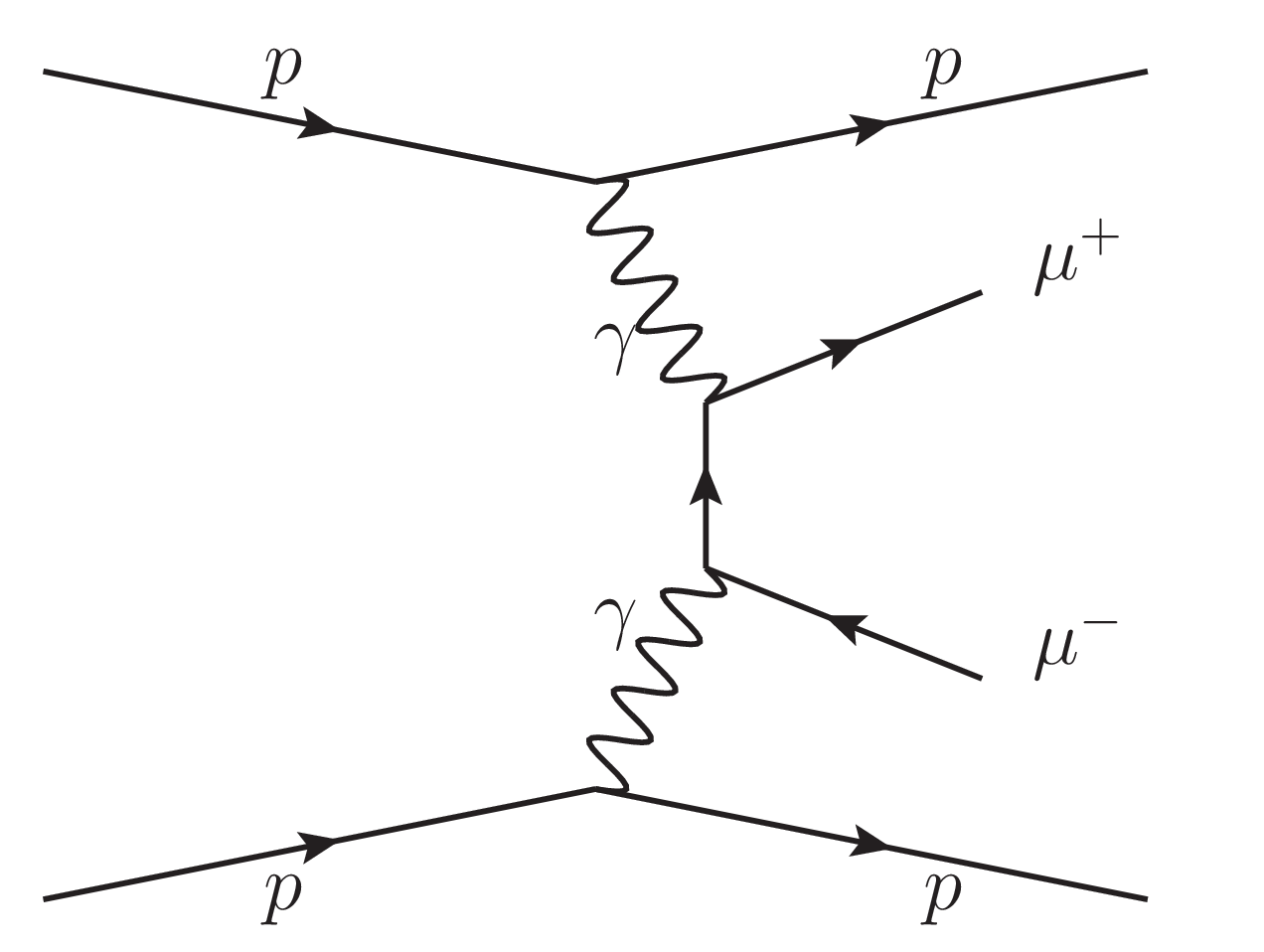
png pdf |
Figure 1-a:
Production of muon pairs by γγ fusion in the double proton dissociation topology. This diagram is considered as a background. |
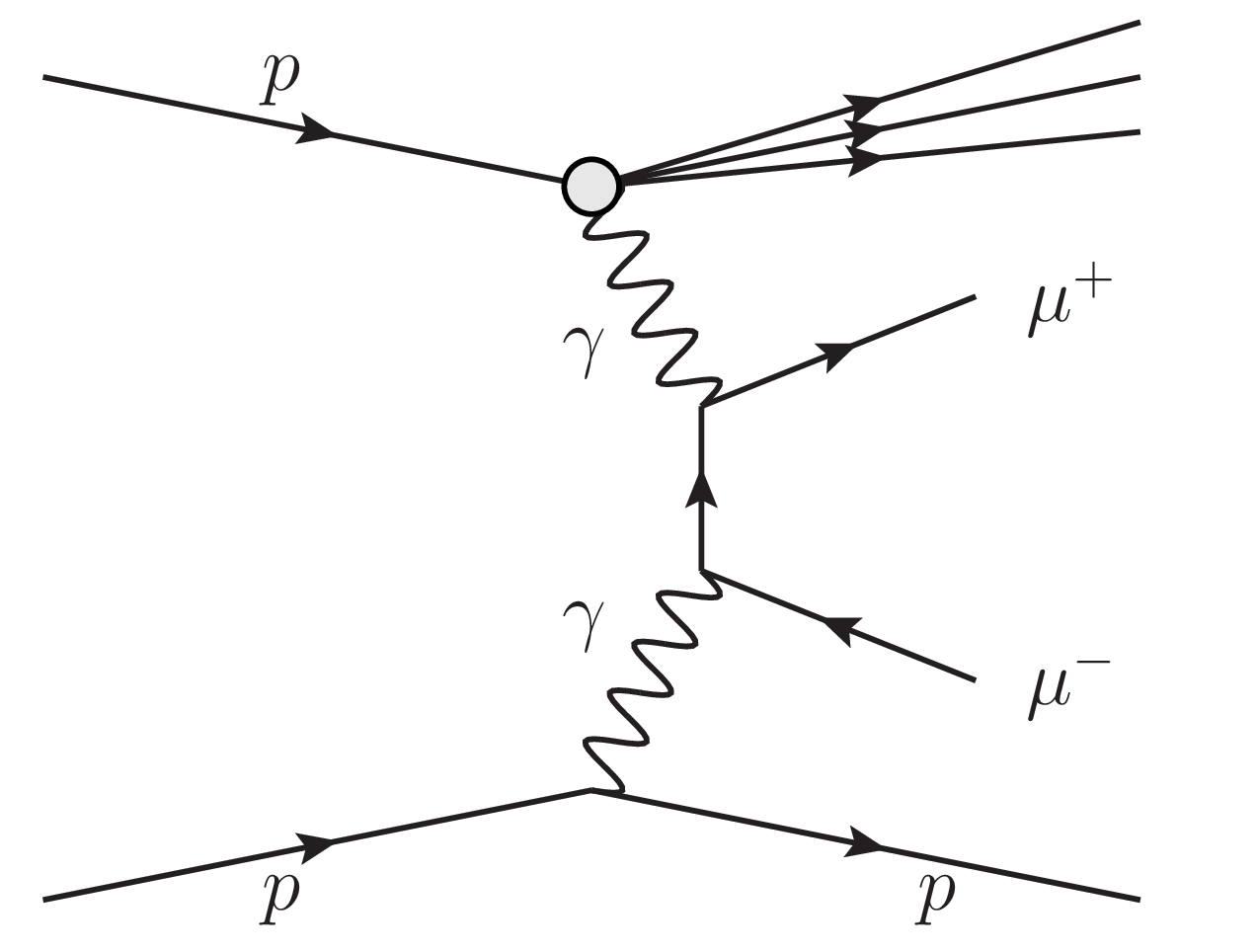
png pdf |
Figure 1-b:
Production of muon pairs by γγ fusion. The "elastic" (left), single proton dissociation (center), and double proton dissociation (right) topologies are shown. The left and center diagrams result in at least one intact final state proton, and are considered as signal in this analysis. The rightmost diagram is considered as a background. |
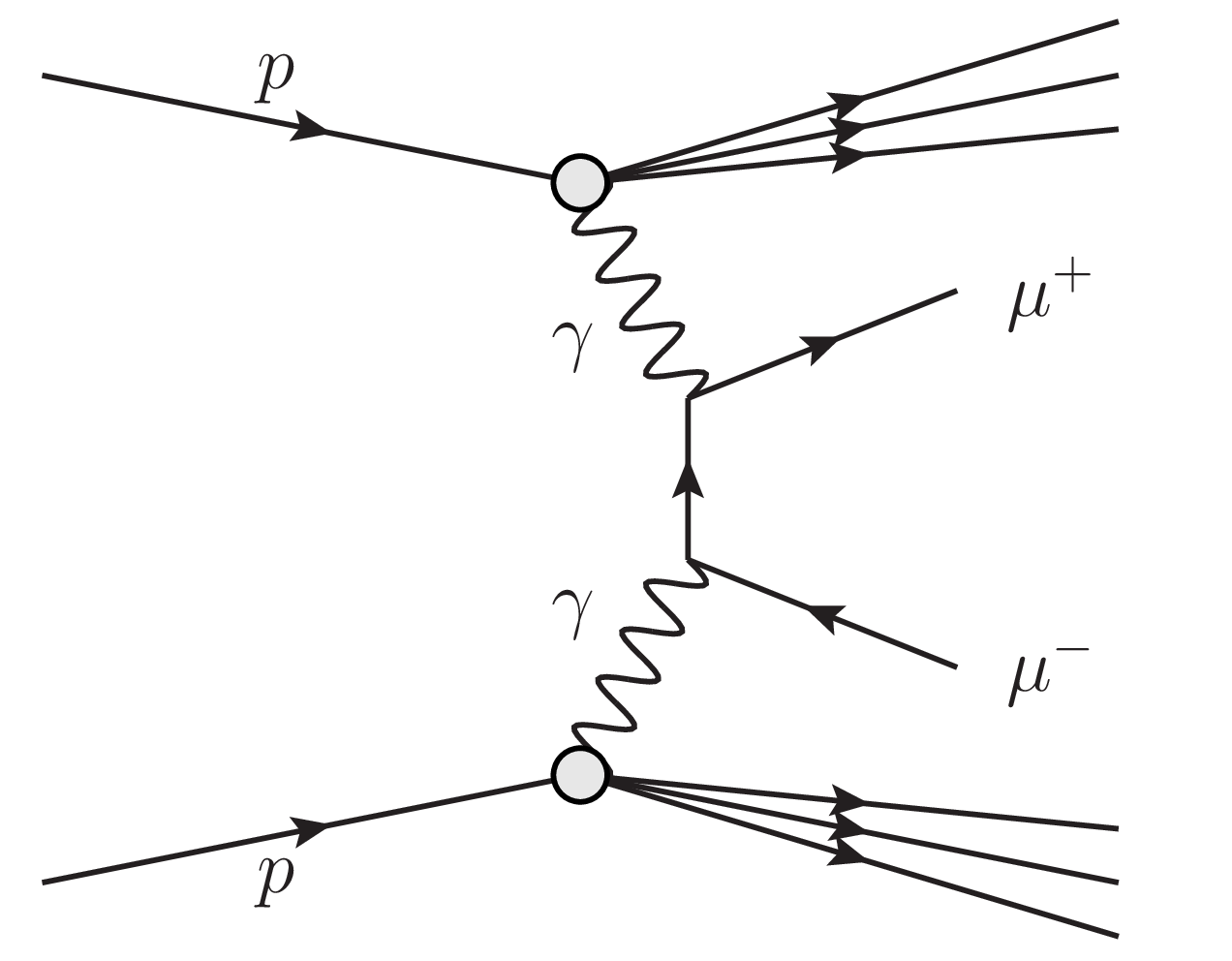
png pdf |
Figure 1-c:
Production of muon pairs by γγ fusion. The "elastic" (left), single proton dissociation (center), and double proton dissociation (right) topologies are shown. The left and center diagrams result in at least one intact final state proton, and are considered as signal in this analysis. The rightmost diagram is considered as a background. |

png pdf |
Figure 2:
The layout of the beam line (seen from above) between the interaction point (IP5) and the region where the RPs are located in LHC sector 56. Dipoles (D1, D2), quadrupoles (Q1-Q6), collimators (TCL4-TCL6), as well as absorbers (TAS, TAN) are shown. The 210 near and 210 far units are indicated, along with the timing RPs. The 220 near and 220 far units (not used here) are also shown. The RPs indicated in red are the horizontal CT-PPS ones; those in blue belong to TOTEM. The red arrow indicates the outgoing beam, while the blue one the incoming beam. The arm in LHC sector 45 is symmetric with respect to the IP. The drawing is not to scale. |

png pdf |
Figure 3:
Example of track impact point distribution measured in RP 210F, sector 45, at 15σ from the beam. The beam center is at x=y= 0. |
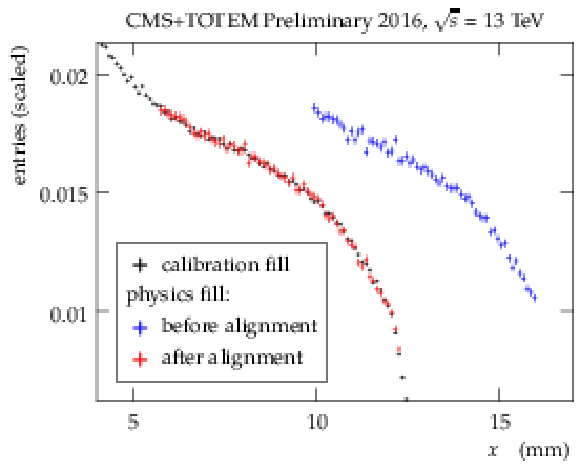
png pdf |
Figure 4:
Distribution of the track impact points as a function of the horizontal coordinate for the alignment fill (black points), a physics fill before alignment (blue points), and after alignment (red points). The beam center is at x=0 for the black and red points; the x axis origin is undefined for the blue points. |
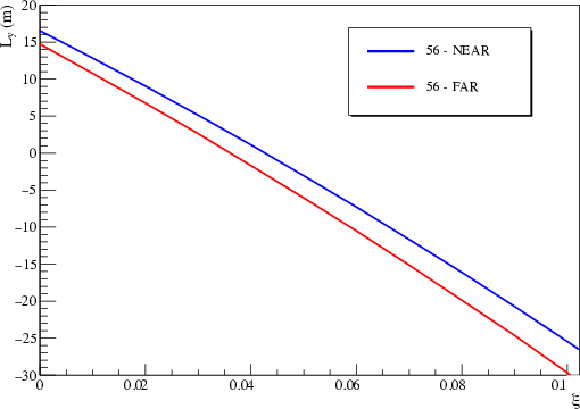
png pdf |
Figure 5:
The vertical effective length Ly as a function of the proton momentum loss ξ at different RPs calculated with MAD-X [6]. |
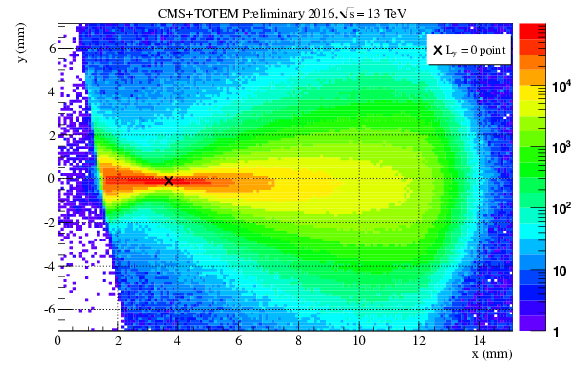
png pdf |
Figure 6:
Distribution of the track impact points measured in RP 210F, in sector 45, in the alignment fill. The point where Ly=0 and its effect in the impact point distribution are shown. The beam center is at x=y=0. |
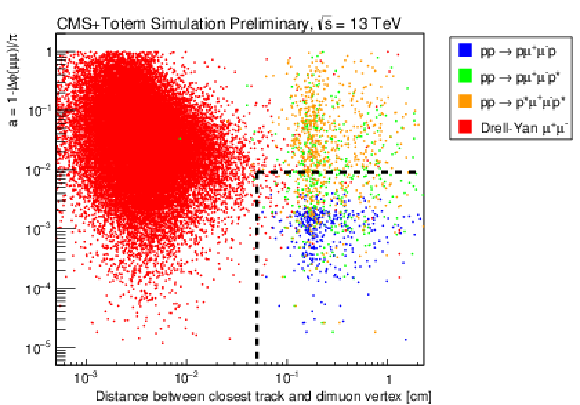
png pdf |
Figure 7:
Dimuon acoplanarity vs the distance between the closest extra track and the dimuon vertex in signal and background simulation. The points represent the simulated Drell-Yan (red), elastic γγ→μ+μ− (blue), single dissociative γγ→μ+μ− (green), and double dissociative γγ→μ+μ− (yellow) processes. The dashed lines indicate the region selected for the analysis. |
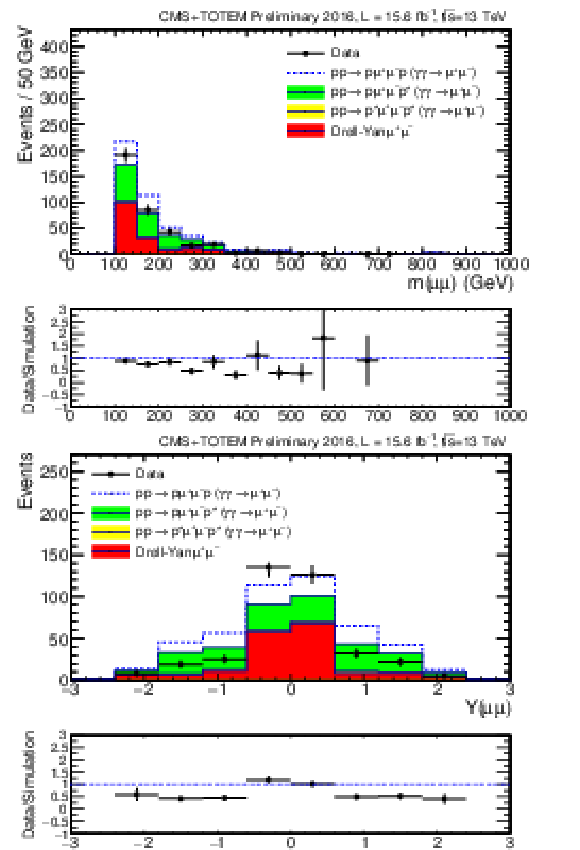
png pdf |
Figure 8:
Dimuon invariant mass (above) and rapidity (below), after all central detector selection cuts. The lower panel in each plot shows the ratio of the data to the sum of all signal and background predictions. |

png pdf |
Figure 8-a:
Dimuon invariant mass, after all central detector selection cuts. The lower panel shows the ratio of the data to the sum of all signal and background predictions. |
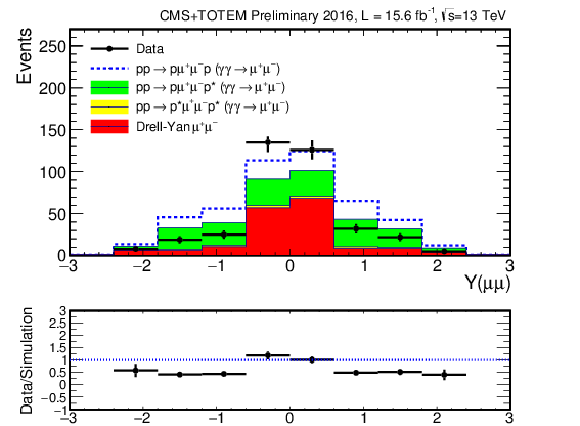
png pdf |
Figure 8-b:
Rapidity, after all central detector selection cuts. The lower panel shows the ratio of the data to the sum of all signal and background predictions. |

png pdf |
Figure 9:
Generator-level relative difference ξ(μμ)−ξ(p)ξ(μμ) vs. ξ(μμ) for single dissociative γγ→μ+μ− production. Of the two possible solutions for ξ(μμ), only the one corresponding to the side with the intact proton is shown. |

png pdf |
Figure 10:
Correlation between ξ(μμ) and ξ measured in the Roman Pots, for both Roman Pots in each arm combined. The 45 (left) and 56 (right) arms are shown. The light shaded region corresponds to the kinematical region outside the acceptance of both the near and far RPs, while the darker shaded region corresponds to the region outside the acceptance of the near RP. For the events in which a track is detected in both, the ξ value measured at the near RP is plotted. |
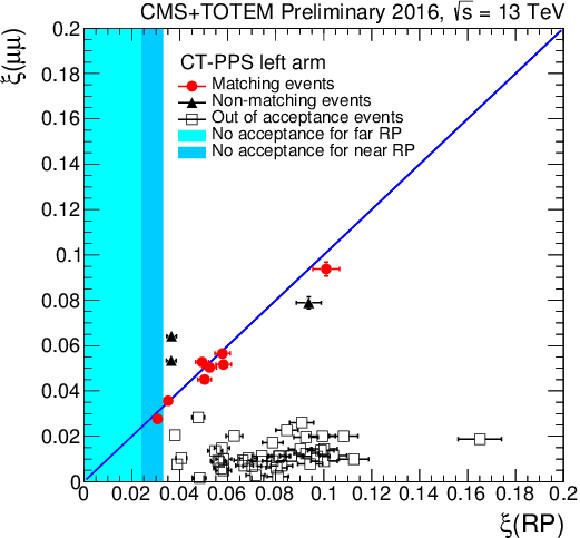
png pdf |
Figure 10-a:
Correlation between ξ(μμ) and ξ measured in the Roman Pots in sector 45, for both Roman Pots combined. The light shaded region corresponds to the kinematical region outside the acceptance of both the near and far RPs, while the darker shaded region corresponds to the region outside the acceptance of the near RP. For the events in which a track is detected in both, the ξ value measured at the near RP is plotted. |
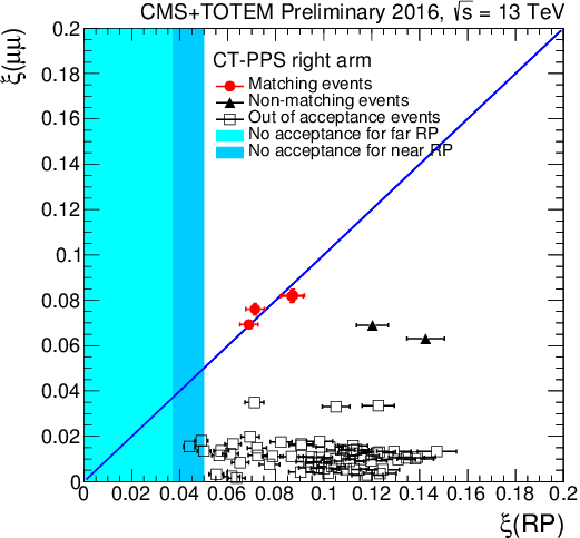
png pdf |
Figure 10-b:
Correlation between ξ(μμ) and ξ measured in the Roman Pots in sector 56, for both Roman Pots combined. The light shaded region corresponds to the kinematical region outside the acceptance of both the near and far RPs, while the darker shaded region corresponds to the region outside the acceptance of the near RP. For the events in which a track is detected in both, the ξ value measured at the near RP is plotted. |
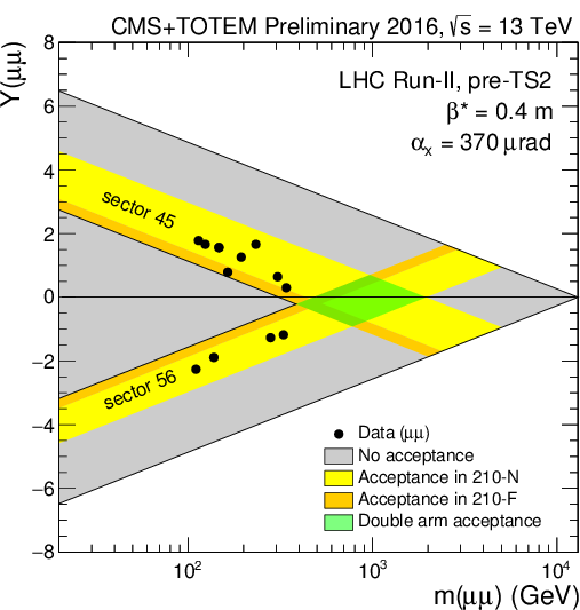
png pdf |
Figure 11:
Expected coverage in the rapidity vs invariant mass plane overlaid with the observed dimuon signal candidate events. Following the CMS convention, the positive rapidity (negative rapidity) region corresponds to the 45 (56) LHC sector. |
| Tables | |

png pdf |
Table 1:
Estimated backgrounds from Drell-Yan production, with proton kinematics matching within 1σ, 2σ, 3σ, and within the full acceptance range in at least one of the FAR and NEAR Roman Pots of a given arm. |

png pdf |
Table 2:
Estimated backgrounds from double-dissociation γγ→μμ production, with proton kinematics matching within 1σ, 2σ, 3σ, and within the full acceptance range in at least one of the FAR and NEAR Roman Pots of a given arm. |
| Summary |
| We have studied γγ→μ+μ− production with forward protons reconstructed in the CMS-TOTEM Precision Proton Spectrometer, using a sample of about 10 fb−1 collected in high luminosity LHC data taking at 13 TeV. The Roman Pot alignment and LHC optics corrections have been derived using a high statistics sample of forward protons. A total of 12 γγ→μ+μ− candidates with m(μμ)> 110 GeV, and matching forward proton kinematics, is observed. This corresponds to an excess larger than four standard deviations over the background. The result confirms the reliability of the alignment and optics determination, and represents the first evidence for proton-tagged γγ collisions at the electroweak scale. The present data demonstrate the excellent performance of CT-PPS and its potential. With its 2016 operation, CT-PPS has proven for the first time the feasibility of operating a near-beam proton spectrometer at a high luminosity hadron collider on a regular basis. |
| References | ||||
| 1 | CMS Collaboration | The CMS experiment at the CERN LHC | JINST 3 (2008) S08004 | CMS-00-001 |
| 2 | M. Albrow et al. | CMS-TOTEM Precision Proton Spectrometer | CERN-LHCC-2014-021. TOTEM-TDR-003. CMS-TDR-13 | |
| 3 | TOTEM Collaboration | Performance of the TOTEM Detectors at the LHC | Int. J. Mod. Phys. A28 (2013) 1330046 | 1310.2908 |
| 4 | J. Kaspar | Alignment of CT-PPS detectors in 2016, before TS2 | CERN-TOTEM-NOTE-2017-001 | |
| 5 | F. Nemes | LHC optics determination with proton tracks measured in the CT-PPS detectors in 2016, before TS2 | CERN-TOTEM-NOTE-2017-002 | |
| 6 | H. Grote and F. Schmidt | MAD-X: An upgrade from MAD8 | Conf.Proc. C 030512 (2003) 3497 | |
| 7 | TOTEM Collaboration | LHC Optics Measurement with Proton Tracks Detected by the Roman Pots of the TOTEM Experiment | New J. Phys. 16 (2014) 103041 | 1406.0546 |
| 8 | J. A. M. Vermaseren | Two Photon Processes at Very High Energies | NP B229 (1983) 347 | |
| 9 | S. P. Baranov, O. Duenger, H. Shooshtari, and J. A. M. Vermaseren | LPAIR: A generator for lepton pair production | in Workshop on Physics at HERA Hamburg, Germany, 1991 | |
| 10 | GEANT4 Collaboration | GEANT4 --- A Simulation toolkit | NIMA 506 (2003) 250 | |
| 11 | J. Alwall et al. | The automated computation of tree-level and next-to-leading order differential cross sections, and their matching to parton shower simulations | JHEP 07 (2014) 079 | 1405.0301 |
| 12 | R. Frederix and S. Frixione | Merging meets matching in MC@NLO | JHEP 12 (2012) 061 | 1209.6215 |
| 13 | CMS Collaboration | Event generator tunes obtained from underlying event and multiparton scattering measurements | EPJC 76 (2016) 155 | CMS-GEN-14-001 1512.00815 |
| 14 | T. Sjostrand, S. Mrenna, and P. Z. Skands | A Brief Introduction to PYTHIA 8.1 | CPC 178 (2008) 852 | 0710.3820 |
| 15 | CMS Collaboration | Performance of CMS muon reconstruction in pp collision events at √s= 7 TeV | JINST 7 (2012) P10002 | CMS-MUO-10-004 1206.4071 |
| 16 | CMS Collaboration | Evidence for exclusive γγ→W+W− production and constraints on anomalous quartic gauge couplings in pp collisions at √s= 7 and 8 TeV | JHEP 08 (2016) 119 | CMS-FSQ-13-008 1604.04464 |
| 17 | CMS Collaboration | Study of exclusive two-photon production of W+W− in pp collisions at √s= 7 TeV and constraints on anomalous quartic gauge couplings | JHEP 07 (2013) 116 | CMS-FSQ-12-010 1305.5596 |
| 18 | CMS Collaboration | Exclusive photon-photon production of muon pairs in proton-proton collisions at √s= 7 TeV | JHEP 01 (2012) 052 | CMS-FWD-10-005 1111.5536 |
| 19 | ATLAS Collaboration | Measurement of exclusive γγ→W+W− production and search for exclusive Higgs boson production in pp collisions at √s= 8 TeV using the ATLAS detector | PRD94 (2016) 032011 | 1607.03745 |
| 20 | ATLAS Collaboration | Measurement of exclusive γγ→ℓ+ℓ− production in proton-proton collisions at √s= 7 TeV with the ATLAS detector | PLB 749 (2015) 242 | 1506.07098 |
| 21 | CDF Collaboration | Search for exclusive Z boson production and observation of high mass pˉp→γγ→p+ℓℓ+ˉp events in pˉp collisions at √s= 1.96 TeV | PRL 102 (2009) 222002 | 0902.2816 |
| 22 | CDF Collaboration | Observation of exclusive charmonium production and γ+γ to μ+μ− in pˉp collisions at √s= 1.96 TeV | PRL 102 (2009) 242001 | 0902.1271 |
| 23 | L. A. Harland-Lang, V. A. Khoze, and M. G. Ryskin | The photon PDF in events with rapidity gaps | EPJC 76 (2016) 255 | 1601.03772 |
| 24 | M. Dyndal and L. Schoeffel | The role of finite-size effects on the spectrum of equivalent photons in proton–proton collisions at the LHC | PLB 741 (2015) 66 | 1410.2983 |
| 25 | L. A. Harland-Lang, V. A. Khoze, and M. G. Ryskin | Exclusive physics at the LHC with SuperChic 2 | EPJC 76 (2016) 9 | 1508.02718 |
| 26 | P. Lebiedowicz and A. Szczurek | Exclusive production of heavy charged Higgs boson pairs in the pp→ppH+H− reaction at the LHC and a future circular collider | PRD91 (2015) 095008 | 1502.03323 |
| 27 | CMS Collaboration Collaboration | CMS Luminosity Measurements for the 2016 Data Taking Period | CMS-PAS-LUM-17-001 | |

|
Compact Muon Solenoid LHC, CERN |

|

|

|

|

|

|